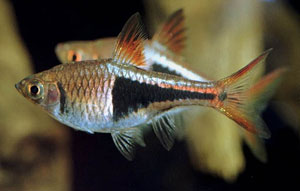Rasbora heteromorpha is just an additional example of nature’s versatility in colour design. The silvery forepart of the body graduates into a rose pink as it nears the centre, which then carries correct via to suffuse most of the tail. The dark marking, shown in the illustration above, from which it gets the well-liked name of harlequin, forms a triangle from the tail, ending in a curve over the spot where the pink and silver combine.
The sex could be determined in a fully developed fish by a golden line running along the top edge of the dark triangle. This is much better coloured and much more pronounced in the male. A further indication is the fuller belly of the female near breeding time.
Feeding on prepared foods keeps the harlequin in reasonable condition, but live foods should be given as frequently as feasible to maintain them in the greatest feasible condition.
Breeding this species is very challenging; even the specialists have not really mastered the method. The unknown quantity has yet to be discovered. The technique as far as recognized is as follows. The temperature should be between 78° and 82° F, and old slightly acid water should be utilized in an aquarium containing broad-leafed plants like Sagittaria gigantea or the larger Cryptocorynes. Courtship should commence within a day or two after the fish are introduced. The female will take up an inverted position, touching her belly on the underside of the leaves. Presently the male will join her, clasping her by curving his body around hers. During this embrace, one or two eggs are discharged on to the leaf, the female remaining in the inverted position.
The action is continued for about two hours and during this period somewhere between 30 and 80 eggs should be laid on the leaves of the plants. The eggs will hatch approximately 18 hours later supplied that the water is kept at a temperature of 80° F.

